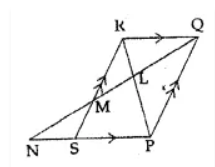Solution:-
From the question it is give that,
Consider the ∆RLQ and ∆PLN,
∠RLQ = ∠NLP [vertically opposite angles are equal]
∠RQL = ∠LNP [alternate angle are equal]
Therefore, ∆RLQ ~ ∆PLN
So, QR/PN = RL/LP = 2/3
QR/PN = 2/3
10/PN = 2/3
PN = (10 × 3)/2
PN = 30/2
PN = 15 cm
Therefore, PN = 15 cm
(ii) Name a triangle similar to triangle RLM. Evaluate RM.

Solution:-
From the figure,
Consider ∆RLM and ∆QLP
Then, ∠RLM = ∠QLP [vertically opposite angles are equal]
∠LRM = ∠LPQ [alternate angles are equal]
Therefore, ∆RLM ~ ∆QLP
Then, RM/PQ = RL/LP = 2/3
So, RM/16 = 2/3
RM = (16 × 2)/3
RM = 32/3
RM =
